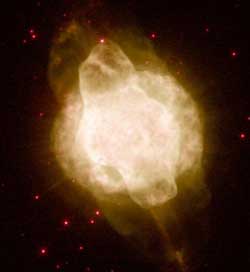Longest atomic state lifetime measured from spontaneous decay in UV

Planetary nebula NGC3918, shown here, is a rare enough environment that atoms refrain from colliding long enough that scientists on Earth can study the spontaneous decay of atoms in very long-lived states. <br>
The internal state of an atom can change by absorbing or emitting bits of light. In a warm gas or plasma the electrons are frequently shuttling back and forth from one state to another. Some of these states are longer lived than others, though, because of extenuating circumstances. For instance, many transitions from an excited state to the ground state occur in nanoseconds, but some can last for tens of seconds or longer. Measuring the true lifetime of the longer-lived of these transitions is difficult for the simple reason that ev en when a sample of atoms is dilute, an atom is being bumped so often that de-excitations come about before the state decays radiatively.
When even the best laboratory vacuum on Earth is still too crowded for making such delicate measurements, persistent scientists turn to outer space. Tomas Brage of Lund University (Lund, Sweden), Philip Judge of the High Altitude Observatory at NCAR (Boulder, CO), and Charles Proffitt of the Computer Science Corporation (Baltimore, MD) resort to viewing excited atoms in the planetary nebula NGC3 918 where, amid the wreckage of a dying star, there is enough energy to excite a toms but a density low enough (a few 1000 per cubic centimeter) that mutual pumping isn’t a problem (see image). Using the Hubble Space Telescope, the three scientists looked at the emissions of excited triply ionized nitrogen atoms and observed a lifetime of 2500 seconds for one particular hyperfine transition. Why is this state so robust?
Brage (tomas.brage@fysik.lu.se, 46-46-222-7724) says that angular momentum can be preserved in this transition only if, in addition to the electron emitting an ultraviolet photon, the nucleus itself flips over. Other than adding to basic knowledge about atomic physics , studies like these should provide spectroscopic information for studying the deaths of stars. (Brage et al., upcoming article in Physical Review Letters, probably 16 December; text at www.aip.org/physnews/select)
Media Contact
More Information:
http://www.aip.org/physnews/selectAll latest news from the category: Physics and Astronomy
This area deals with the fundamental laws and building blocks of nature and how they interact, the properties and the behavior of matter, and research into space and time and their structures.
innovations-report provides in-depth reports and articles on subjects such as astrophysics, laser technologies, nuclear, quantum, particle and solid-state physics, nanotechnologies, planetary research and findings (Mars, Venus) and developments related to the Hubble Telescope.
Newest articles

Trotting robots reveal emergence of animal gait transitions
A four-legged robot trained with machine learning by EPFL researchers has learned to avoid falls by spontaneously switching between walking, trotting, and pronking – a milestone for roboticists as well…

Innovation promises to prevent power pole-top fires
Engineers in Australia have found a new way to make power-pole insulators resistant to fire and electrical sparking, promising to prevent dangerous pole-top fires and reduce blackouts. Pole-top fires pose…

Possible alternative to antibiotics produced by bacteria
Antibacterial substance from staphylococci discovered with new mechanism of action against natural competitors. Many bacteria produce substances to gain an advantage over competitors in their highly competitive natural environment. Researchers…





















